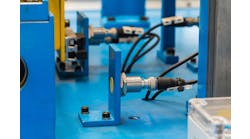Mike Bacidore is the editor in chief for Control Design magazine. He is an award-winning columnist, earning a Gold Regional Award and a Silver National Award from the American Society of Business Publication Editors. Email him at [email protected].
Sensing color can open up several options for machine builders, but making the choice isn’t a black-and-white decision.
This panel of automation suppliers explains the need for speed and the advantages of a microprocessor-equipped sensor, as well as when monochrome sensors or contrast sensors are appropriate.
Meet the panel
Greg Trainor, sensors & safety North American business unit manager, Datalogic
Steve Nylund, president, Delta Computer Systems
Tim Kelley, vice president, U.S. sales, Tri-Tronics
Luis Torralva, North American marketing manager, Telemecanique Sensors
Ryan Hinrichsen, applications engineer, Banner Engineering
Jack Moermond, marketing manager, object detection sensors, Balluff
Felicia Shu, design specialist, Teledyne Dalsa
What sorts of speeds can be expected from color sensors, and is there a need for greater speed?
Nylund: Color sensors typically have a response time of 1 millisecond or slower. This is adequate for most applications. If the application calls for detecting a single color at high speeds, then contrast sensors, which typically operate about 10 times as fast, may provide a solution.
Kelley: Some color sensors can process for sortation of different hues as fast as 90 microseconds. Others are much slower. If the sensing application is to determine precise color hue or intensity/shade, then the sensor requires more processing time and can slow the inspection time down to as much as 1 millisecond or more. Time in the inspection/verification process is always increasing. Throughput in production is the overriding cost factor, and precision of delivered quality product is a constant customer requirement.
Torralva: We can find color mark readers as the most standard application on bagging or labeling machines. Speeds can go from 2.5 m/s to 10 m/s for a 1 mm wide mark, but of course machines are improving their speeds and customers are looking more and more for faster sensors. Color sensors will need more time for processing and identify the color, so speeds are much lower.
Also read: Can automation industries simplify color sensing?
Hinrichsen: True color sensors are typically used to detect color marks on a moving web. As the marks get smaller and the speed of the web gets faster, there is always a need for faster responding color sensors.
Moermond: Response time, which is the time it takes to switch the output once the object has been detected, for color sensors can be as fast as 300 µs. Switching frequencies can be as fast as 2,000 Hz. There will always be a need for greater speeds as cycle times are being increased to meet production demands and machine speeds.
Trainor: Industrial photoelectric color sensors offer speeds with response times measured in microseconds. For example Datalogic’s S65-V series color sensor has a response time of 340 microseconds. With an increased emphasis on throughput in all sectors of manufacturing, sensor speeds will have to keep pace and provide even faster response times.
Many color sensors now can include a microprocessor. What sorts of advantages does that enable?
Moermond: Microprocessors in color sensors allow configuring of the sensor outputs based on a particular color needing to be evaluated with configuration software. Additionally, some color sensors are now able to reside directly on I/O networks that allow them to provide diagnostics to the main controller. Also, the controller can provide parameterization of the sensors in the event a sensor is replaced or during recipe changes. In the past color sensors usually could be taught to detect three colors maximum. With the color sensors that reside on networks, as many as 256 colors can be detected by one sensor. Some sensors can communicate via RS-232 or other serial networks providing more data than just discrete on-off outputs.
Kelley: I’m not certain if there are many true color sensors that are made today that do not use a microprocessor to evaluate the many different color differences. Microprocessors allow any given sensor to resolve the many millions of color differences faster, more accurately and, more importantly, with more consistent repeatability than an analog or a strictly digital circuit can provide.
Nylund: Microprocessor-based color sensors offer many advantages. The most important one may be the Teach mode, whereby the color sensor can be taught a number of sample colors and can automatically provide an output based on the best match to the taught colors. Low-end color sensors may only be capable of three Teach outputs, while high-end color sensor can do 10 or more. This allows complex color recognition to be reduced to a set of discrete outputs that can connect in an inexpensive PLC. The second and related benefit is that the color sensor can “talk” to a computer to allow easy setup of parameters to optimize operation. Thirdly, the microprocessor allows for averaging of readings to reduce noise and improve performance with challenging colors and to automatically compensate for changes to temperature and other variables.
Torralva: Including microprocessor improves the speed and also the variety and quantity of colors you can detect.
Hinrichsen: A microprocessor allows a sensor to do much more advanced things. It allows for several independent outputs for different colors, including color intensities, and it provides for much more accurate teach procedures. Having a microprocessor also allows Banner to easily customize a sensor's programming to tailor it for specific applications.
Just because a process includes colored objects, it doesn’t necessarily require a color sensors. When might a monochrome sensor suffice, and what are the factors that warrant color?
Trainor: Color sensors are necessary when you absolutely have to tell if, for example, blue is blue or yellow is yellow, or if the sensed item is one of a variety of pre-programmed colors. If you need to detect a variance in the shade or intensity of a colored object, a color sensor is necessary. A monochromatic sensor can be used in simple contrast applications for presence or absence. For example, if you want to see that a blue sticker on a white background is present, a simple red, LED, monochromatic sensor should work fine.
Shu: I agree that a color sensor is not a “must” just because a process includes colored objects. In my opinion, if color identification and/or color fidelity is not the only requirement in an application, a color sensor is not necessarily required. For example, monochrome sensors are widely used in traffic cameras. Furthermore, if high-resolution, high-resolving power and/or high speed are desired in a high-end imaging application like astronomy cameras, a monochrome sensor is preferred to a one-shot color sensor.
Color images can be created with a monochrome sensor or a sensor array by capturing separate mono images through special color filters or under controlled color illumination and then converting these monochrome images into a single full color image. In order to warrant a true representation of color, monochrome sensors are expected to provide higher resolution, higher sensitivity, higher dynamic range, and lower noise floor. Some combination of these factors and a few components of the acquisition chain will determine if a mono sensor camera system meets the requirements of a color application. Besides, the state-of-the-art algorithm used to restore the color information in a mono sensor camera system is also a key to the quality of the reconstructed image.
Nylund: Monochrome sensors may be adequate if there are a small set of colors that separate well enough just using shades of gray. On the other hand, color sensors can struggle with shades of the same color. High-end color sensors provide means to handle both situations and are usually a safer choice, especially if the color mix may change in the future.
Hinrichsen: A monochrome sensor, also often called a contrast sensor or intensity-based sensor, detects changes in the amount of its own light reflected back by the colored material with a grayscale imager. Because different colored material reflects different amounts of light depending on what the color of light is, a user can often find a color of light that gets the appropriate amount of contrast between the amount of light that is reflected by the color mark and the amount of light that is reflected by the background web. These single-color intensity sensors may emit red, blue, green or even white light to achieve that contrast. If a background web contains several other colors or reflectivity such that no single-color intensity sensor can distinguish the color mark from another condition on the web, the application may require a true color sensor with a color imager.
Torralva: For standard applications in packaging, a monochrome sensor could be enough, but when it comes to printing or quality control machinery we see color detection more often.
Kelley: Monochrome sensors, to my knowledge, are more camera-based solutions. When a customer requires to sort color, accept/reject certain color criteria, or verify the color for quality control purposes, there are many options available. And true, not all products that are colored have any requirements for quality, verification or inspection. The determination of which technology to use is based on many different criteria, including cost, speed of lines, accuracy of solution, ease of use and support and complexity of setup. A monochrome camera solution may very well work in many occasions, but it seems it would be more expensive than conventional color sensors and may take a bit more setup and stall time.
What about contrast sensors? When are they good enough or not good enough for color applications?
Kelley: There are many applications that a standard contract sensor may do the job—for example, two-color sorting, registration-mark sensing, label detection. The determination can be insisted upon by the customer or sold by the manufacturer’s rep/distributor, or may simply be applied incorrectly by the application engineers. The good-enough question can only be approved by the customer—does it solve the problem completely, fast enough and accurately enough?
Moermond: Contrast sensors are able to distinguish one color compared to a background, provided there is enough brightness difference or color difference between the two colors. If there is a need to sense, compare more than two colors or several various colors to ensure that the right colored objects are packaged together. Then color sensors would be the preferred method.
Nylund: Contrast sensors, also called color mark sensors, are well-suited for applications where a defined mark must be detected on a fast-moving web. An example would be detecting registration marks in a printing operation. As long as there is enough difference in color between normal color and the registration mark, a contrast sensor works well. Otherwise, they suffer the same issues as monochrome sensors.
Trainor: Contrast sensors are highly specialized and are typically used in very high-speed, short-range applications to detect a subtle contrast change or a color mark. Typical color sensors may give you a variety of outputs, each assigned to fire when a particular color comes into view. A contrast sensor will only tell you that something has changed or that the single color mark you wanted to see is present.
Torralva: When the color of the mark is not a decision factor in your machine and you only need to detect the presence of the mark, a contrast sensor could be a good solution and more cost-effective.
Homepage image courtesy of Stuart Miles at FreeDigitalPhotos.net












